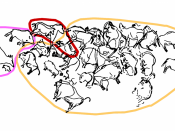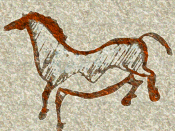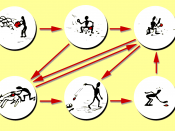Geographic and Temporal Range of Cave Art
The people of the upper Paleolithic left behind many
clues to how they lived and what they did. But unlike anything
before them, they have left clues to why they did what they did.
The clues are in the art they left behind in caves.
Dates, Styles, and Geographic Range
Upper Paleolithic art is comprised of at least three
periods, the Aurignacian, the Solutrean, and the Magdalenian.
The dates for these are now estimated at: Aurignacian 35,000-
20,000 B.C. The Solutrean 20,000- 15,000 B.C. The Magdalenian
14,000- 8,000 B.C. The ranges of these dates change as new
material is uncovered. For example one book, Primitive Art, puts
these dates around 20,000 years earlier (Fagan, 1995:136),
(Christensen, 1955:314).
These periods are again separated into smaller periods.
The Aurignacian I and II, the Gravettian around 23,000 B.C. also
known as the Perigordian. The Proto-Magdalenian, the
Aurignacian, the Proto-Solutrean, the Solutrean, the Proto-
Magdalenian I and II, and the Middle and Upper Magdalenian
(Leroi-Gourhan, 1967:493).
See chart 1 (Leroi-Gourhan, 1967:493)
The art of the Aurignacian does not exist in caves, it is
found on small bone fragments and stone slabs. They show early
attempts at representaion using simple lines and colours (Leroi-
Gourhan, 1967:206). The representations shown are mostly
animal's heads, forequarters, and dorsal lines. The style
changed from a hard continuous profile showing only the
forequarters to a more free standing pose showing most of the
body (Huyghe, 1957: 31). No action or foreshortening is shown in
the early art of the Aurignacian. This may indicate a lack of
understanding of perspective (Huyghe, 1957:21).
The Gravettian is a period where eastern and western
Europe underwent a vast cultural exchange (Leroi-Gourhan,
1967:208). The Magdalenian period is where we find almost all
(80% according to Fagan, 1995:137)...


